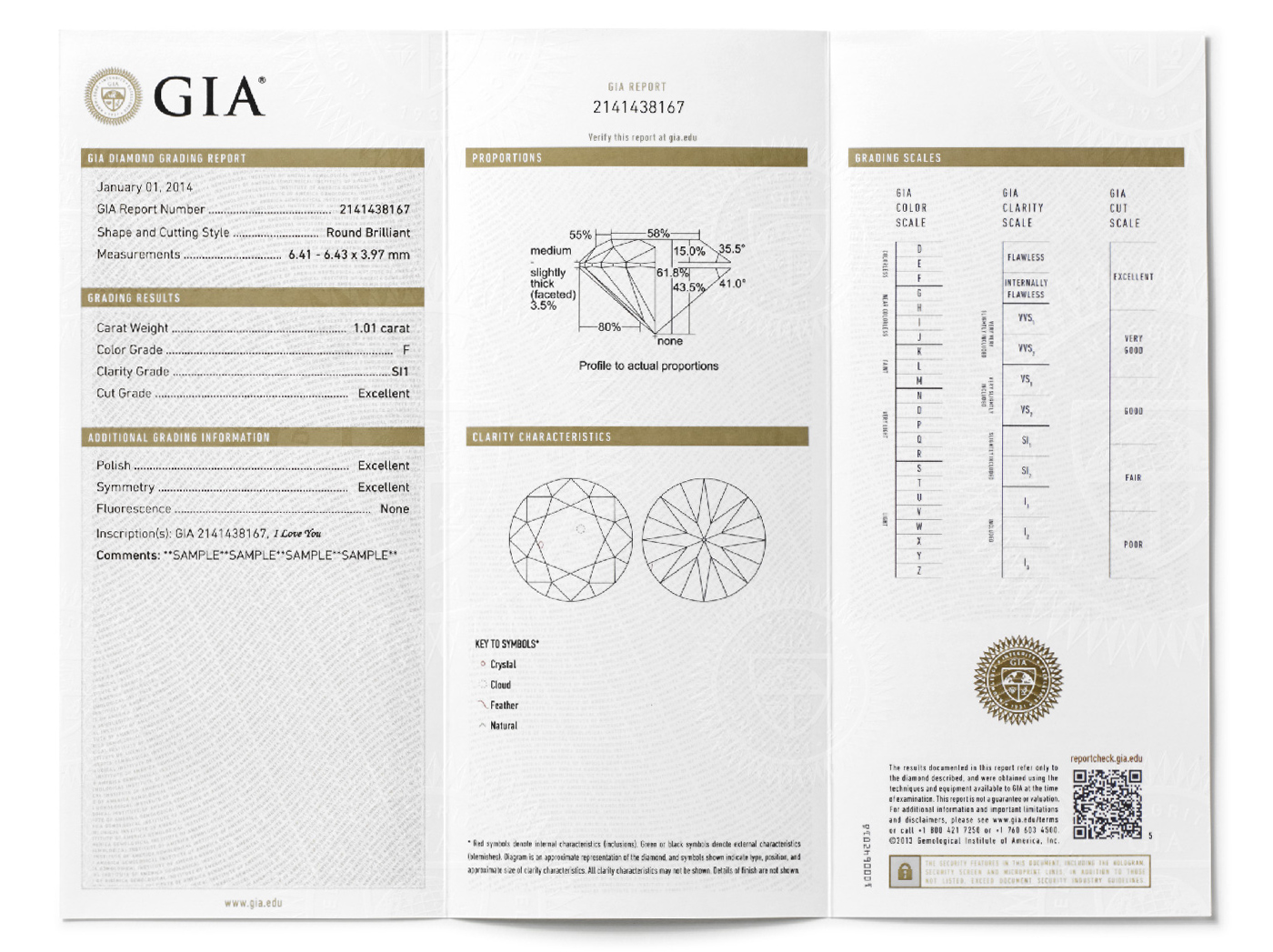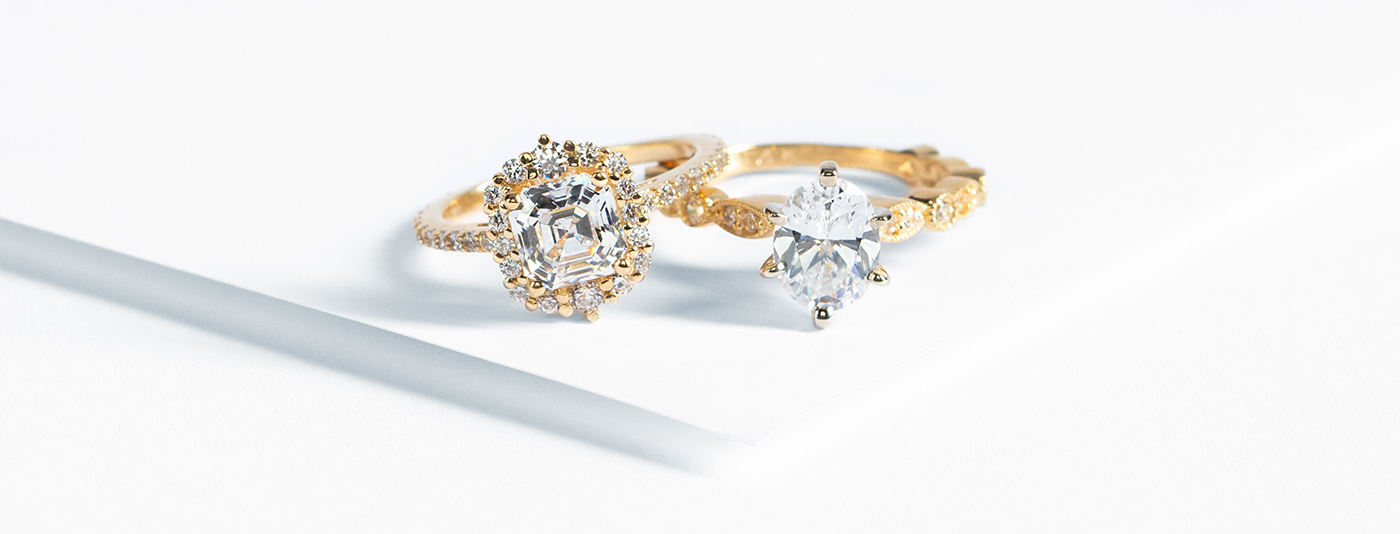How to Tell if a Diamond is Real
/ Lindsay Kazan
When you’re embarking on the search for the perfect genuine diamond, it’s not always an easy journey. With the investment associated with a diamond purchase, most people spend a significant amount of time determining how to buy a diamond from a reputable jeweler and then searching for the best stone.
In the quest to find and create more affordable simulated diamond jewelry options, manufacturer’s have pursued technological advancements to produce diamond alternatives and diamond simulants. However, the downside of this is that a number of fake diamonds have appeared on the market that are not very high quality and can easily mislead an uninformed consumer.
On the other hand, there are also lab created diamonds that are beautiful, high quality and available at a much more affordable price point. As a consumer, it’s important to know the difference in the diamond quality scale as it relates to price so that you don’t end up with a low quality gemstone or fall for a scam. The best way to mitigate these risks is to develop a deeper understanding around how to tell if a diamond is real.
HOW CAN YOU TELL IF A DIAMOND IS REAL
Gemologist
The best way to determine if it’s a genuine diamond is real is to take it to a skilled gemologist for evaluation. However, there are also a number of at-home tests you can use to help identify a potential fake stone. Some of these tests will only be feasible to perform on a loose stone, but others could be done with a mounted diamond that has already been set into a piece of jewelry, whether it’s a diamond bracelet or ring. If you own a piece of Diamond Nexus jewelry set with Nexus Diamond™ alternatives, we do not recommend performing any of the following methods to determine chemical composition. The Nexus Diamond alternative is made of a proprietary substrate and will not test as a natural diamond.
 If you’re wondering how to know if a diamond is real, it can be determined right in the comfort of your home. Here’s how you can test stones you believe to be diamonds to see if they are real or not:
If you’re wondering how to know if a diamond is real, it can be determined right in the comfort of your home. Here’s how you can test stones you believe to be diamonds to see if they are real or not:
The Scratch Test
As one of the hardest substances on earth, diamonds are capable of cutting through glass. This quality of an authentic diamond can help you test the realness of a gemstone in your possession. To perform the scratch test, you’ll need a loose diamond and a small plate of glass. Placing the glass on a flat surface, use your diamond to gently scratch its surface. If the gem does, in fact, leave a scratch, it’s real. While this test seems simple enough, it’s important to understand that this process could potentially damage your diamond and may not be the most effective way to determine the quality of your stone as other gemstones can have a similar effect on glass too. However, it does give you a place to start your investigation.
The Fog Test
Another quick way to help identify a potentially fake diamond is to breathe on it. You can perform this diamond test on either a loose or set stone. If the fog left behind by your breathing quickly clears, your diamond is real. If the surface of the gem remains cloudy for a few seconds, you might be looking at a fake one. This technique is derived from the concept that diamonds disperse heat instantaneously, making it impossible for the fog to linger. A synthetic diamond will not have the same ability. However, for this test to work, the surface of your diamond must be clean and free from any oils, which may not always be feasible.
The Transparency Test
This is a test that can only be done on a loose stone. To perform it, you will need a piece of newspaper or another paper document. Place your diamond face down over a section of text with the cutlet, or point, facing up. If you can read the letter through the stone, it is likely a fake diamond. However, if the letters are blurry, it may be an indication that you have an authentic diamond. Prior to performing this test, make sure the surface of your stone is clean to avoid a blur mistakenly appearing as the result of dirt or oils.
The Floating Test
This method is perhaps one of the easiest ways to test a loose diamond. To conduct the floating test, simply grab a glass of water and drop your diamond into it. The density of a real diamond will cause it to quickly sink to the bottom of the glass, while a fake stone will often float. Of course, this diamond test can only be performed on a loose stone as any additional weight of the setting would impact the results.
The Fire Test
If you are willing to risk potential damage to your diamond jewelry, there is a definitive method to put it to the test. For this test, hold your stone in a flame for approximately 30 seconds then drop it into a cold glass of water. If the stone is a real diamond, it will remain unharmed by the water. If it is a fake one, however, it will shatter into pieces when subjected to the difference in extreme temperatures. This is the result of weaker materials not being able to handle the rapid rate of expansion and contraction due to temperature changes.
The Diamond Scale Test
A more scientific method by which to test diamonds is to use a diamond scale at home or at a local reputable jeweler. Different diamond simulants and alternatives have unique weights in comparison to natural diamonds, depending on the chemical composition of each. For example, cubic zirconia is a synthetic material that weighs approximately 55% more than natural diamonds. It’s best to perform this test using two diamonds of the same size and diamond shape, one of which you know the composition of to compare against. You may also be able to compare a stone’s weight to what is listed on its diamond certificate or grading report if available. A discrepancy would indicate that the diamond may be fake. This test is best suited to determine the difference between diamonds that are significantly different in quality in composition, as some diamond alternatives are very similar to a natural diamond in weight, feel and sparkle.
Even with the variety of at-home tests, you’ll get the strongest results by taking your diamond to a gemologist or appraiser to be evaluated and inspected. These professionals have access to specialized equipment that can help identify real and fake diamonds from one another. This specialized equipment can pinpoint differences in a stone’s composition that can’t be distinguished by the naked eye. It’s also important to ask for a stone’s certification or grading report when you’re purchasing a GIA diamond. This can help put your mind at ease by outlining the specifications of the stone you’re purchasing. If a jewelry store or manufacturer does not have a diamond certificate available, you may be better off making your purchase elsewhere to avoid fraudulent stones.

THE DIFFERENCE OF LAB GROWN DIAMONDS
Are lab grown diamonds real? Lab grown diamonds, also known as synthetic diamonds, are often confused as being fake or fraudulent stones, but this is a false misconception. Thanks to significant technological advancements, many simulated lab grown diamonds look and feel very similar to natural diamonds. Developing a better understanding of the qualities of lab diamonds and natural diamonds can help you distinguish between the various diamond options.
Perhaps the most obvious difference between a mined diamond and a lab grown diamond is its creation and procurement. Natural diamonds have developed below the earth’s surface over millions of years. Subjected to intense pressure and extremely high temperatures, carbon compounds harden together to produce what we all know as a natural diamond. These stones reside at depths of 150 to 200 kilometers below the earth’s surface until they are mined from the ground through intense practices that can have significant environmental and labor costs.
Alternatively, lab diamonds use technology to create the same beautiful stones at a fraction of the cost while also minimizing environmental impacts. The process of their creation occurs in a highly-controlled laboratory setting that imitates the high pressure and temperature conditions found in nature to generate diamonds.
 While many lab-grown diamonds are created via similar methods, not all are created equally. One of the most significant factors of production is the chemical composition used to create the synthetic diamond, as the appearance of the stone will be largely influenced by the chemical composition. Mined diamonds are formed almost entirely of carbon, which results in many of the unique properties most closely associated with diamonds. Lab-grown alternatives, on the other hand, can vary greatly in composition.
While many lab-grown diamonds are created via similar methods, not all are created equally. One of the most significant factors of production is the chemical composition used to create the synthetic diamond, as the appearance of the stone will be largely influenced by the chemical composition. Mined diamonds are formed almost entirely of carbon, which results in many of the unique properties most closely associated with diamonds. Lab-grown alternatives, on the other hand, can vary greatly in composition.
From zirconium dioxide – used to produce cubic zirconia – to proprietary formulas like those used by Diamond Nexus, the distinct composition is key to understand when assessing the quality of different diamond engagement ring options. It has the ability to affect everything from how diamonds are cut to their durability and color. For example, zirconium dioxide results in stones that are very soft and easily become cloudy or discolored. On the other hand, Nexus Diamond™ alternatives are made with a patented formula base in order to imitate the highest quality factors of natural diamonds on the GIA scales.
Equipped with the education about a true diamond’s authenticity and qualities, measurement factors and composition differences, you will be prepared to assess whether a diamond ring is real. Knowing this will help you avoid making a fraudulent purchase that could otherwise cost you thousands of dollars. It can also help when determining how to clean your engagement ring. When in doubt, simply ask the seller to furnish the GIA diamond certification or grading report. It’s always important that you have a good relationship with your jeweler or diamond ring company and trust their advice in all things relating to your true diamond. When you establish this type of rapport, you can make your diamond jewelry purchase with confidence.
For simulated lab diamond engagement rings that don’t sacrifice quality or break the bank, consider the Nexus Diamond™ alternative.
*Diamond Nexus strives to provide valuable information, while being clear and honest about our products. The Nexus Diamond™ alternative is a patented lab created diamond simulant that, among all simulants, most closely imitates the look, weight and wear of a diamond, with two exceptions – it is absolutely perfect in every way, and it costs significantly less. Price points and environmental facts expressed in this blog were taken from popular online retailers and may vary. Learn more about the environmental impact of mining by visiting our blog.

